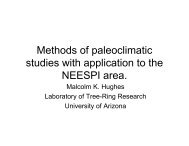Ground Truth Studies Teacher Handbook - Aspen Global Change ...
Ground Truth Studies Teacher Handbook - Aspen Global Change ...
Ground Truth Studies Teacher Handbook - Aspen Global Change ...
You also want an ePaper? Increase the reach of your titles
YUMPU automatically turns print PDFs into web optimized ePapers that Google loves.
A <strong>Global</strong> <strong>Change</strong> Primer (continued)<br />
2 Biogeochemical Dynamics<br />
An essential part of reliably predicting change on a global scale is an adequate understanding of the cycling of the<br />
key nutrient elements — carbon, nitrogen, oxygen, sulfur, and phosphorous — through their major reservoirs: the<br />
oceanic and freshwater aquatic systems, the solid Earth component, the biosphere, and the atmosphere. Subelements<br />
include: greenhouse warming, acid deposition, deforestation, coastal pollution, and ozone depletion.<br />
3 Ecological Systems and Dynamics<br />
These are important to global change as both cause and effect. Ecosystems provide food and fiber for humans and<br />
wildlife. They also influence air and water quality, the amount and distribution of surface and ground water, and the<br />
habitats of both human and wildlife. Therefore, ecosystem destruction has direct effects on our economic and social<br />
well-being. Variables such as temperature, precipitation, and biotic interactions ultimately control the distribution of<br />
species. Species, in turn, influence the characteristics of ecosystems, and ecosystems influence the physical environment<br />
through such phenomena as reflectance, evapotranspiration, and the emissions of important greenhouse gases,<br />
such as carbon dioxide and methane. Therefore, ecosystems with altered structural and functional properties can<br />
have feedback effects on the physical and chemical environment. Sub-elements include: biodiversity, coastal<br />
pollution, sea level rise, erosion, ozone depletion, greenhouse warming, and acid deposition.<br />
4 Earth System History<br />
The Earth’s geologic record provides a valuable source of information about past changes in climate, ecosystems,<br />
hydrologic conditions, and landscapes. Evidence of major variations in sea level, lake and ground water levels,<br />
extent of glacier ice and sea ice, changes in atmospheric composition, and dramatic changes in ecosystems in the past<br />
provide us with important insights into what the future may hold. We learn about natural climate variability by<br />
indicators such as tree rings, ice cores, fossils, and sediment. Information about the causes, rates, and consequences<br />
of climate change can also be extracted from the geologic record. Such information can improve our ability to make<br />
predictions about future climate change.<br />
5 Human Interactions<br />
Human activity is a critical element in global change, both in terms of initiating processes of change, as well as<br />
altering ongoing processes. Research into the human dimensions of global change will help us to understand the<br />
patterns of direct human action or impact, as well as the indirect structural and institutional causes of change in Earth<br />
systems, including such factors as economic markets, national legal and regulatory systems, and social and economic<br />
aspirations of various nations. Such research will provide the scientific background for public policy studies, which<br />
should address the response of human institutions to global change in terms of both mitigation strategies and<br />
processes of adaptation.<br />
© ASPEN GLOBAL CHANGE INSTITUTE 1995 GROUND TRUTH STUDIES<br />
13


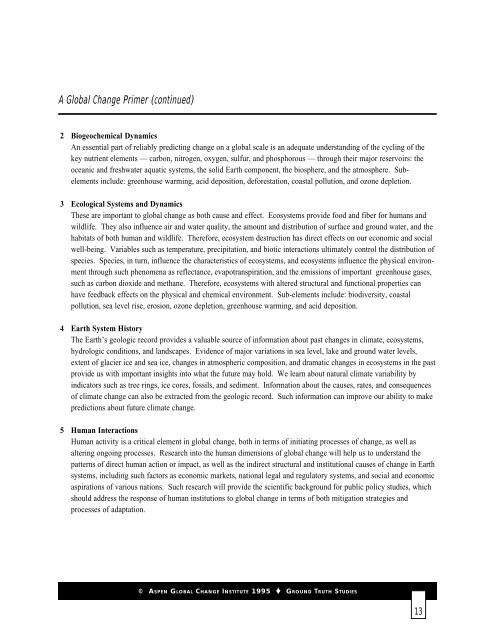
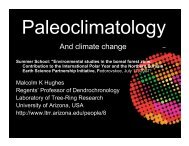


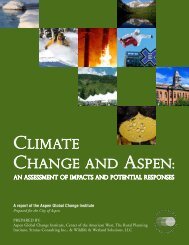

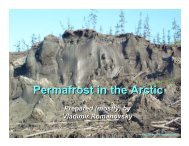
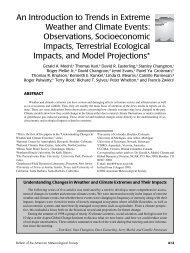
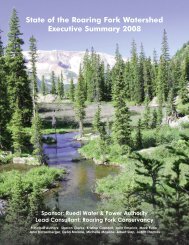
![View Powerpoint Slides [PDF]](https://img.yumpu.com/32486693/1/190x146/view-powerpoint-slides-pdf.jpg?quality=85)
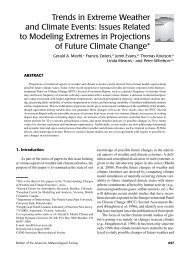

![View Powerpoint Slides [PDF]](https://img.yumpu.com/29411106/1/190x143/view-powerpoint-slides-pdf.jpg?quality=85)

